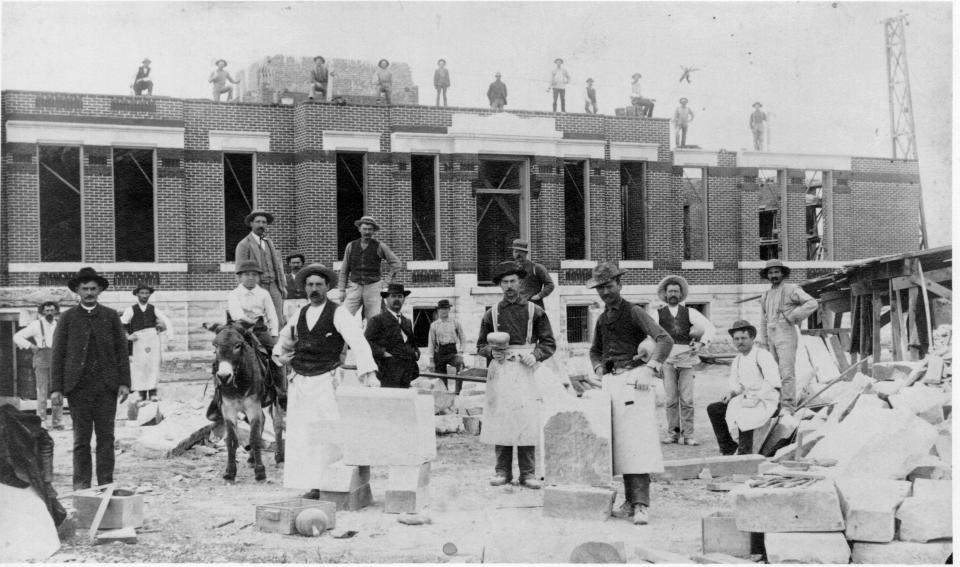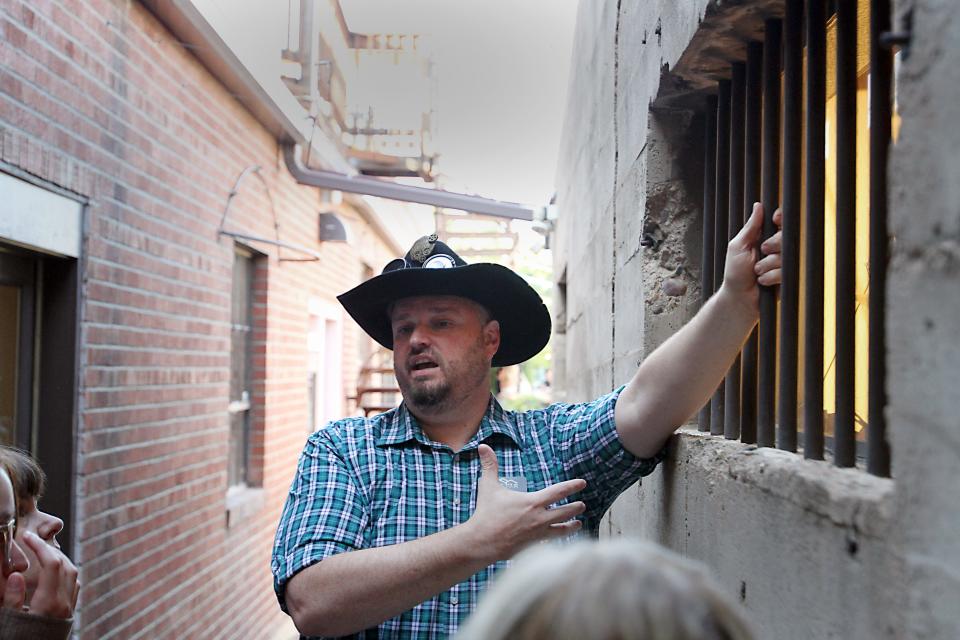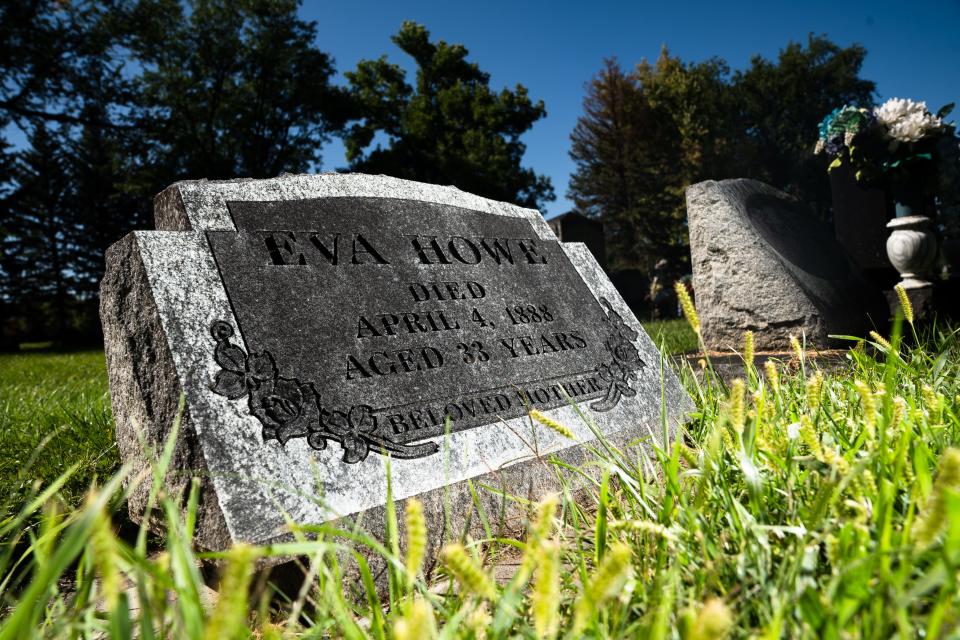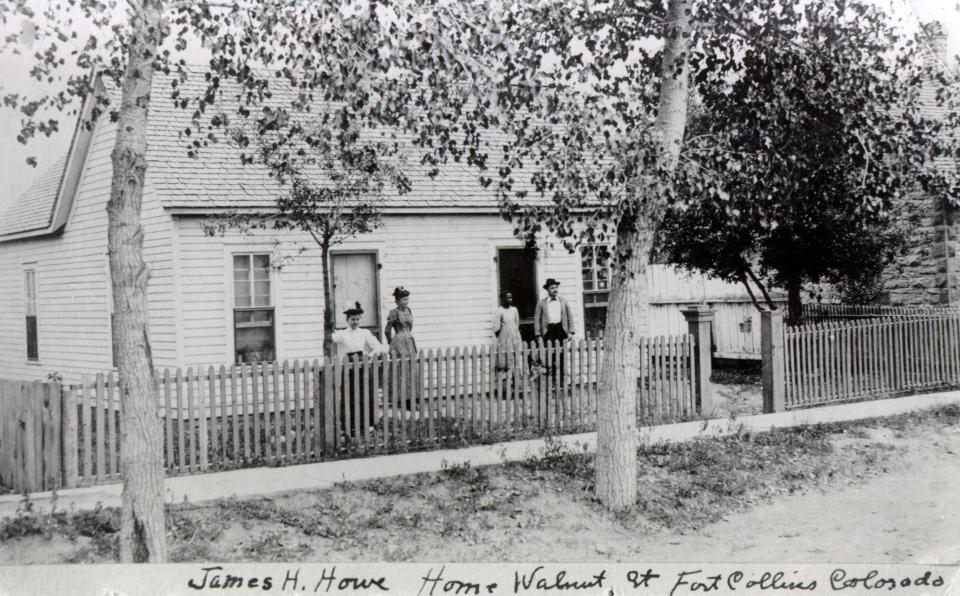135 years after one of Fort Collins' most infamous crimes, we unravel its final mystery
Editor's note: This story references domestic violence, murder and suicide. Resources for those in crisis have been included at the end of this story.
Earlier this summer, a Fort Collins tour guide dressed in Victorian garb led me and half a dozen others down into a dark, stone-walled basement under Old Town.
It was cold and cramped and smelled remarkably good — while built as Fort Collins' first dedicated firehouse and city hall back in 1882, it's now home to Happy Lucky's Tea House and the basement storeroom is filled with loose-leaf teas.
The basement space was also used as one of Fort Collins' early jails, our host Em Gonzales explained. So now, besides being lined with boxes of tea, it's a central stop on Fort Collins Tours' weekend ghost tours and was a fitting setting for the first story of the evening: the infamous tale of James and Eva Howe.
I was there for another reason — for Gertrude — but you'll learn about that soon enough.
It all started on April 3, 1888, Gonzales said, when James came home drunk from the Fort Collins saloons. James was a respected resident of the small pioneer town ― a talented and successful millwright with a wife, young daughter and tidy, picket-fenced home on Walnut Street.
He was also a violent alcoholic who beat his wife, Eva, so badly that April night that she reported him to the authorities. She didn't want him arrested, newspaper accounts would later say, and instead asked a deputy to stay close to the Howe home that night. Eva awoke the following morning with a plan.
After her husband left their house, Eva took the couple's daughter, Gertrude, to a neighbor. Later that morning, she found a place to store her belongings with the intention of leaving Fort Collins with Gertrude, who was then about 6 years old.
While Eva's father, David Schuyler, had died in upstate New York when she was just a girl, Eva's mother, Jane, later remarried and was living in Canada with her husband, Oliver Vandewark. That's where Eva would take her little daughter.
But James came home early that afternoon, and after presumably catching his wife in the process of packing up to leave him, stabbed her in the neck with his pocket knife, the Fort Collins Courier reported.
She managed to get through the front door, call out "Murder!" and stumble into the couple's front yard, where she reportedly collapsed in full view of witnesses. They came to Eva's aid. A doctor even rushed to the Howe house on horseback, but Eva was already dead. She was about 33 years old.
James was taken to the county jail at Mason and Oak Streets without incident, witnesses told the Courier.
News of Eva's brutal and public murder spread through town that afternoon. By 8 p.m., Fort Collins' new electric lights had mysteriously been cut, and the town was plunged into darkness. A mob of unnamed men — some masked, some not — formed outside the jail.
Using chisels and hammers, they broke James out of his cell and dragged him to the county courthouse, which was under construction. He begged them not to do it. He told the crowd he had a brother and sister in Kansas City. Then he went quiet. The mob hanged James from a nearby construction derrick that night, making him Fort Collins' first and only known lynching victim. The Courier labeled James' death "Tragedy Number Two" of that ill-fated April day.

But this story isn't really about James and Eva Howe.
It's about Gertrude, their little girl who became an orphan ― and a footnote in one of Fort Collins' most infamous crimes ― in the matter of a day.
After her parents' deaths, little Gertie was taken to Kansas to live with her aunt, one person told me.
No, it was Canada, said another.
She married an Ohio shoe salesman. Wait, an electrician.
And one day, when she was an old woman, she returned to Fort Collins to visit her childhood hometown.
Those are the rumors. But what are the facts?
I spent three months trying to find out — poring over census records and city directories, ingratiating myself with the research librarians of upstate New York and Ohio. I called descendants of those April 4 witnesses.
"Have you ever heard of Eva Howe?" I asked sheepishly, before stumbling through the tragic tale of her murder and little daughter's unknown fate.
The answer was always no.
But I kept trying.
After 135 years without answers, I had become obsessed. It was time to finally unspool the enduring mystery of Gertie Howe.
How the Howe story has lived on in Fort Collins
In the fall of 1997, Fort Collins history fans met at Grandview Cemetery to hear the tragic tale of Eva Howe in her own words — kind of.
Eva was one of several Fort Collins figures featured that year in Grandview's then-new Cemetery Stroll — an annual living history presentation where actors portrayed notable residents buried in the sprawling graveyard.
For the next 20 years, until the Cemetery Stroll disbanded, she was occasionally brought back as a featured character at the annual event.
Around 2011, when Fort Collins Tours opened, Eva and James became central figures on its weekend ghost tours. Before its closure in 2017, Pateros Creek Brewing Co. added a James Howe-inspired beer to its rotating tap list: the "Howe's It Hangin'" American IPA.

Local historian Meg Dunn attributes much of the fascination surrounding the couple to the fact that James — a well-to-do white man — is the city's only known lynching victim.
The brutal and public nature of Eva's murder added another layer, and the local prohibition movement was galvanized around her death. Ultimately, Eva's tragic end would help usher in Fort Collins' prohibition, Dunn said. It remained a dry town from 1896 to 1969.
And then there's Gertrude. While typically reduced to a line in the larger story of her parents' deaths, Gertrude's name is mentioned in a few newspaper articles and history books.
"I think anybody who reads about this case — because it’s in a lot of different Fort Collins history books — I have to believe that they're just heartsick over the fact that young Gertrude was left an orphan in one day," Fort Collins Police Services historian Tom McLellan said. "I always felt horrible about that and wanted to know what happened."
Over the years, both Dunn and McLellan looked into Gertrude's fate.
They both found that Gertrude — or Gertie, as she was often called — went to live with her maternal grandmother and step-grandfather in Canada.
At some point, McLellan said, he heard Gertie stopped through Fort Collins as an old woman and that her visit was reported in the newspaper. He ran to his computer to try to confirm that but found nothing.
Dunn tracked down records listing various Gertrude Howes in New York — where the Howe family was originally from — but none had enough corroborating information to make Dunn feel like she'd found the right Gertie.
"Maybe she became a nurse. Maybe she became a nun," Dunn said, referring to the various documents she tracked down but was never able to confirm.
"We don't know what happened to Gertie, really," she added. "It's a mystery."
Tracing the fate of Gertie Howe
On April 19, 1888 — after a whirlwind two weeks and breathless coverage — the Courier printed its last update on the Howe saga.
Gertie Howe had left for Cannington, Ontario, with her maternal grandmother, Jane, earlier that week, it read.
Details of their departure were sparse. From what I can tell, the tiny front page blurb was the last local mention of Gertie Howe.
From there, she and her grandparents, Oliver and Jane Vandewark, exist in the sparse details provided by census documents and city directories. In 1891, they were living in Cannington. In 1900, the family had settled in West Dover, Delaware, where Oliver owned a farm. Not long after that, they moved back to Canada, according to The Delawarean.
While Oliver was originally from New York, he reportedly owned land in Fort Collins in the 1870s. By 1880, when James and Eva moved from New York to Fort Collins, Oliver's son, Elmore Vandewark, and half-brother, Martin Vandewark, were both living in the Northern Colorado pioneer town.
Oliver had left his first wife and son when Elmore was a baby, and the two never had a relationship, according to Elmore's great-granddaughter, Johanna Whiteman. Oliver was also not close to his half-brother, as Martin was about 20 years younger than Oliver.
Still, Martin Vandewark hosted Eva and James' funerals at his Jefferson Street home in 1888, the Courier reported. Years later, when writing out the history of the Vandewark family in 1946, Elmore's son Willis Vandewark mentioned Eva, James and Gertie.
Willis, who would have been about 19 years old at the time of Eva's murder and James's lynching, touched on the events in the document — calling James a very handsome man with whiskers that came down to his waist. He was "very pleasant ... when sober," Willis wrote.
Little is mentioned about Gertie, but Willis did write that she went on to marry an Ohio shoe salesman named William Argue.
While I was unable to confirm the couple's connection to Ohio or the shoe industry, a marriage listing from Niagara Falls, New York, shows a Gertrude Howe marrying a young electrician named William Argue just before Thanksgiving 1902.
By 1904, William and Gertie can be found in the Buffalo, New York, city directory — listed at the same address as Gertie's grandparents.
Tragedy Number Three
Gertie Howe was born around 1882. She could have feasibly lived into the 1960s, maybe even the 1970s.
She could have been a nurse or a nun, a mother or grandmother.
Instead, she was the third and final tragedy of the Howe family.
In the early morning hours of Aug. 17, 1908, 27-year-old Gertrude Argue attempted to end her life by drinking a household disinfectant, The Buffalo Commercial reported. She died about 10 days later at a Buffalo hospital, leaving behind her husband, William.
"They had no children," Willis wrote matter-of-factly in his Vandewark family history. "They are all dead now."
Oliver had died two years before Gertrude in a church home in Buffalo. Jane followed in 1917. Both are buried in the family plot in Pomfret, New York, alongside Eva's father, David Schuyler, Eva's baby sister, Augusta, and an infant son of James and Eva who died at birth, according to cemetery records.
William's fate is largely unknown. Census records indicate he was born in Canada — the baby in a large farming family that ultimately immigrated to the U.S. He remained in Buffalo for a few years after Gertie's death, according to city directories.
From there, a William Argue who was roughly around the right age moved from Buffalo to Cleveland, Ohio, where he worked as an electrician at a construction firm. He died there in 1937, aged 61, and was buried in a cemetery near the western banks of Lake Erie.
I never found Gertie's final resting place. She's not in the family plot in upstate New York or the simple cemetery in Cleveland.
You won't find her grave in Grandview Cemetery. Of the large, 10-grave plot purchased for Eva and James in 1888, they are the only two people buried there, according to cemetery records. Their graves both went unmarked for more than a century until Fort Collins Tours led a community fundraiser to pay for a headstone for Eva in 2013.

There are no descendants of James and Eva Howe to speak to — no more graves to find or family trees to trace.
Only one remnant of their life in Fort Collins remains.
It's no longer white and its picket fence is long gone. It's definitely not on Walnut Street anymore. But the family's tidy home is still standing 135 years later — unsuspectingly tucked off of a quiet street near City Park.
The little house on Walnut Street lives on
I was afraid to call Greg Ferri earlier this summer.
After all, how do you tell somebody the house they've lived in for 20 years was the site of one of Fort Collins' most infamous murders?
Thankfully, when I mentioned Eva's name, I was met with recognition. Greg knew all about his home's dark past, and he was willing to meet up to talk about it.
When I showed up to the Ferris' front door several weeks later, I was greeted by Greg, his wife Melissa, their aging Jack Russell terrier, Casey, and plenty of stories.
They start in 2002, when Greg was biking past the house and saw an "open house" sign out front. He and his now ex-wife were in the market so, intrigued, he peeked inside.
Nobody was there. The listing agent had left to take down the open house signs around the neighborhood.
"So I just walked in. I walked in to about here," Greg said, gesturing toward the home's cozy living room, "and just felt this really warm embrace.”
"Who knows where that came from, right? It wasn’t nothing. I noted it. I sensed that. It was real. I don’t feel that going into places," Greg said.
That feeling — combined with the little home's location and sprawling backyard — sold Greg. He decided to try for the house.
“When my realtor called me the evening we made the offer, he said, ‘they accepted your offer, but there’s something you need to know about the house.’ And then he faxed this over," Greg recalled, sliding over a photocopied newspaper article about Eva's murder and James' lynching.
It included a picture of the couple's house, which the realtor explained was the same house Greg had just offered to buy. After decades on Walnut Street, it had been moved to its current location in the 1940s, according to a photo of the home in the Fort Collins history archive.
Greg's first thought? "Cool!" he said.

Reading through the article, certain details stuck out to Greg — namely the fact that James had stabbed Eva with a pocket knife with a three-inch blade.
Earlier that day, before putting in the offer on the house, Greg's father had mailed him a Swiss Army knife with a three-inch blade and a sticky note. "Here, I thought you could use this," it read.
"That was very weird. My dad didn’t send me knives every day,” Greg said with a laugh. “I thought that was like an arrow from mana telling me this was my place.”
It's an odd house, Greg admits. Built around 1884, it's small and sectioned off, with its only bathroom and primary bedroom located just off its kitchen. Its second bedroom, located on the west side of the home, is now used as Melissa's closet and dressing room. Back in 1888, it was likely Gertie's bedroom.
There have been a couple unexplained occurrences in the house, Greg said, but nothing glaring. Sometimes, when the couple's motion-detected kitchen faucet goes off for seemingly no reason, they'll yell, "Eva, quit it," Melissa said.
"Anything that goes on around here, we blame Eva," Greg added.
While the couple finds humor in their home's unusual past, Greg was quick to note that they do feel for Eva and Gertrude. One Halloween night several years ago, they even made the trek to Grandview to visit Eva's grave.
Before my call earlier this summer, Greg said he had known James and Eva had a daughter, but he never knew her name. Like many others I spoke to for this story, he had been part of the game of telephone that has long surrounded Gertie. At one point, he heard she went to live with an aunt in Kansas.
Sitting in the Howes' former parlor and armed with my months of research, I ran Greg and Melissa through what I had gleaned about Gertie — how she went to live with her grandparents in Canada, how I thought I'd traced her to New York where she married William Argue and settled into married life in Buffalo.
Then I read through that article from the Buffalo Commercial — by far my least favorite find in this monthslong journey.
Getrude Argue, likely our Gertie Howe, died in 1908 after drinking poison, I told them.
The air left the room. It wasn't the end any of us wanted for Gertie.
After a pause, Greg drew in a breath.
"Another victim," he said.
Domestic violence resources
If you or someone you care about is in a domestic violence situation, call Crossroads Safehouse's 24/7 helplines, which are staffed by trained advocates: 970-482-3502 or 888-541-7233 (toll free). You can also call Alternatives to Violence at 970-669-5150.
Resources for people in crisis
National Suicide Prevention Lifeline: 1-800-273-8255, or call 988
SummitStone Crisis Stabilization Unit, 24 hours a day, 7 days a week: summitstonehealth.org/services/
UCHealth Poudre Valley Hospital and Medical Center of the Rockies crisis centers: uchealth.org/services/behavioral-health/
This article originally appeared on Fort Collins Coloradoan: What happened to Fort Collins murder victim Eva Howe's daughter?

